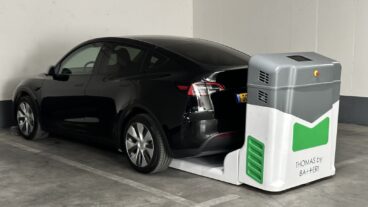Built to replace human selectors or random check ups of visitors, the SDS-VR-1000 is based on the assumption that sophisticated terrorists might not be included in suspect lists.Not many terrorists walk into an airport waving a banner announcing who they are. They don’t carry handguns or try to conceal explosives as they debark from an international flight into the United States. And just as rarely do they have police records.
So how can US officials go about identifying potential terrorists? A new solution is Israel’s Suspect Detection Systems (SDS) – a company that has developed an advance automated filtering tool for identifying potential suspects with hostile intentions among masses of tens of thousands visitors.
Consider it a personal polygraph machine, that will make air travelers infinitely safer, says SDS CEO Shabtai Shoval, a former division manager at Comverse Technology who founded SDS along with former head of the Israel Police’s polygraph division Yeshayahu Horowitz and former deputy Mossad chief Amiram Levin.
“Our system makes an initial assessment within three minutes. If the system identifies a suspect, he can be sent to a personal agent to complete the investigation,” Shoval said.
Shoval explained that the inspiration his journey from Comverse to airport security was spurred by the September 11 attacks, as well as a viewing of a Tom Cruise movie.
“I happened to see the movie Minority Report – with Tom Cruise. I thought to myself, how great it would be to be able to prophesize a crime before it happens,” he told ISRAEL21c.
“Among my staff in the telemarketing division of Comverse were two people formerly from the Shabak (Israel’s General Security Services). After 9-11, we said to ourselves, maybe we should change direction toward the field of homeland security. ‘What’s the major problem that 9-11 has presented to the world,’ we asked?
“Our conclusion was the fundamental issue that international terrorism has gotten sophisticated enough to enable terrorists to get into the target country without any weapons and with their own identity. Therefore, they can then create a strategic terror attack from within, without carrying in any means with them,” he said.
Built to replace human selectors or random check ups of visitors, the SDS-VR-1000 is a device based on the assumption that sophisticated terrorists might not be included in suspect lists and will not carry weapon or explosives when they approach a checkpoint.
“We came to this conclusion two years ago – and since then, that idea has only been reinforced with the Spanish train explosion and the Chechnyan school takeover. It plays out again and again. International terrorists are getting inside a country without weapons, under their own identity and are succeeding in changing history,” said Shoval.
According to Shoval, there are two basic ways to combat this threat – either through good intelligence, or through being able to detect them when they try to enter a country.
“Intelligence is a problem – since most potential terrorists haven’t been on a suspect list. So you need to look for intention. This has to be done with the handicap of not being able to look for weapons, since carrying a weapon into the US, for example, would be stupid since it’s so easy to obtain weaponry once they’re inside,” he said.
“If only you could have each person trying to enter the US go through a polygraph test with a specialist, you could prevent terrorists from entering – but of course that’s not realistic. But, can we create a machine – that uses the basics of polygraph technology – that works automatically without the specialist, and takes only three minutes?”
The SDS system does just about that. It is based on the belief that the terrorist’s fear will be reflected in measurable psycho-physiological parameters.
“As they say in the movies, we have the technology to do this – to use artificial intelligence in software to imitate polygraph capabilities It took a long time -two years – and lots of trial and error through tests conducted in Israel. But we’ve achieved a success rate of 95%,” said Shoval.
The way it works is that the passenger approaches the machine – they put their passport on a scanner and their other hand on a sensor. He is then presented with an array of written questions in the language indicated by the passport (or in an audio mode with earphones if requested). A special detector then measures physiological responses.
“What is does is collect objective data out of the passenger’s ID – and it analyzes the data compared to the subjective data it collects while the passenger is asked different questions,” said Shoval. “The process takes approximately three minutes, and the passenger either receives a transfer printout authorizing him to advance to the next stage of entry to the country, or an announcement that he is required for further questioning. A monitoring official will then escort the passenger to another area for further questioning.”
The system has been approved by the Israeli security apparatus, and an experimental version is going to be tested this year in an American airport.
“We’ve passed all the lab tests in Israel – with the involvement of various security involvement – and now this year, it will be field tested in Israel and in the US. Once it’s on the market, each system will cost approximately $200,000 and will service about 40,000 per year. We’re talking to Boeing and Accnture about partnerships as well as looking for a VC strategic investor in the US,” said Shoval.
According to Shoval, the SDS system is a truly unique product, one that could only have been developed in the cultural and political climate of his country – and he lists three reasons why.
“First, it’s based on the methods developed by the Shabak and El Al, Israel’s national carrier.
Second, the field tests in Israel were unique -only here can you find a population (in Gaza) where 95% of the population has been in an ongoing conflict with their authorities. It’s a fine tuning issue to find which people among those 95% are actual terrorists. If you cross that barrier, there’s no place in the world where it can’t work. Even in Iraq, only about 30% of the population have been involved with confrontations with the US Army and ruling Iraqi forces.
“And third – it took Israeli boldness to go ahead with a plan involving full contact polygraph with civilians, a concept that the US would not have been able to initiate. Americans chose not utilize human selectors – partly due to budget, and partly because it’s difficult to educate the selector how to define between the different kinds of profiling. Here, our system is doing it for you – there’s no human element involved.
“It’s like a robot selection process – we don’t make the decision to take someone out of line and put him in jail – we only take someone for further investigation. There’s no profile selecting and no human rights violations,” he said.
We’ve created a single-track minded machine – it can do just one task – ID a terrorist.”












